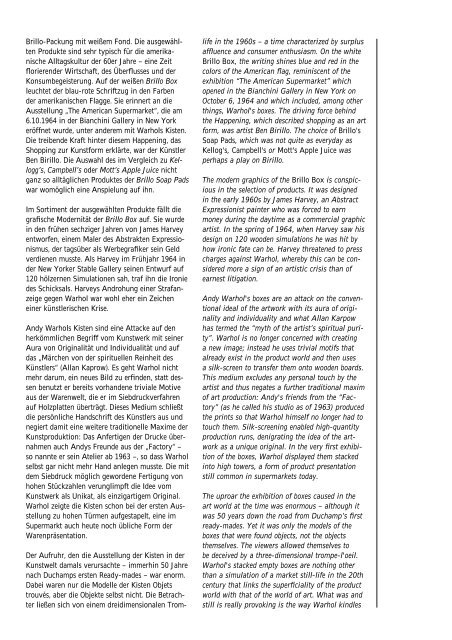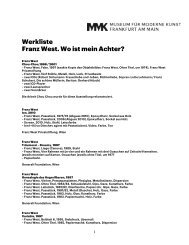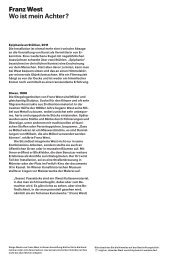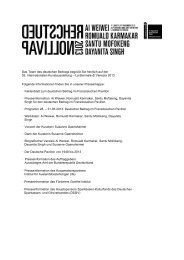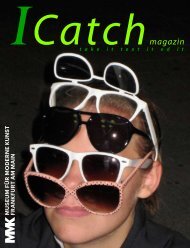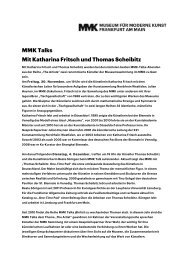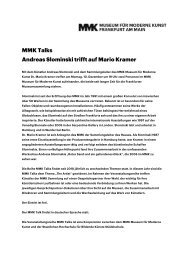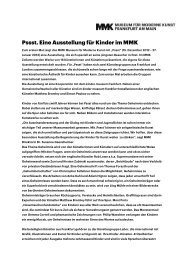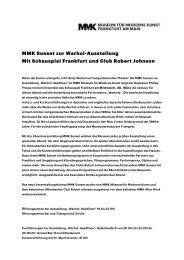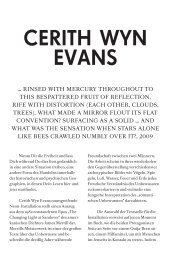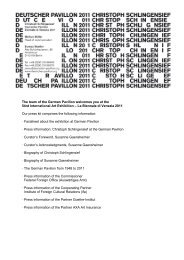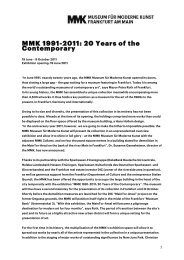Andy Warhol - Museum für Moderne Kunst
Andy Warhol - Museum für Moderne Kunst
Andy Warhol - Museum für Moderne Kunst
Sie wollen auch ein ePaper? Erhöhen Sie die Reichweite Ihrer Titel.
YUMPU macht aus Druck-PDFs automatisch weboptimierte ePaper, die Google liebt.
Brillo-Packung mit weißem Fond. Die ausgewählten<br />
Produkte sind sehr typisch <strong>für</strong> die amerikanische<br />
Alltagskultur der 60er Jahre – eine Zeit<br />
florierender Wirtschaft, des Überflusses und der<br />
Konsumbegeisterung. Auf der weißen Brillo Box<br />
leuchtet der blau-rote Schriftzug in den Farben<br />
der amerikanischen Flagge. Sie erinnert an die<br />
Ausstellung „The American Supermarket“, die am<br />
6.10.1964 in der Bianchini Gallery in New York<br />
eröffnet wurde, unter anderem mit <strong>Warhol</strong>s Kisten.<br />
Die treibende Kraft hinter diesem Happening, das<br />
Shopping zur <strong>Kunst</strong>form erklärte, war der Künstler<br />
Ben Birillo. Die Auswahl des im Vergleich zu Kellogg’s,<br />
Campbell’s oder Mott’s Apple Juice nicht<br />
ganz so alltäglichen Produktes der Brillo Soap Pads<br />
war womöglich eine Anspielung auf ihn.<br />
Im Sortiment der ausgewählten Produkte fällt die<br />
grafische Modernität der Brillo Box auf. Sie wurde<br />
in den frühen sechziger Jahren von James Harvey<br />
entworfen, einem Maler des Abstrakten Expressionismus,<br />
der tagsüber als Werbegrafiker sein Geld<br />
verdienen musste. Als Harvey im Frühjahr 1964 in<br />
der New Yorker Stable Gallery seinen Entwurf auf<br />
120 hölzernen Simulationen sah, traf ihn die Ironie<br />
des Schicksals. Harveys Androhung einer Strafanzeige<br />
gegen <strong>Warhol</strong> war wohl eher ein Zeichen<br />
einer künstlerischen Krise.<br />
<strong>Andy</strong> <strong>Warhol</strong>s Kisten sind eine Attacke auf den<br />
herkömmlichen Begriff vom <strong>Kunst</strong>werk mit seiner<br />
Aura von Originalität und Individualität und auf<br />
das „Märchen von der spirituellen Reinheit des<br />
Künstlers“ (Allan Kaprow). Es geht <strong>Warhol</strong> nicht<br />
mehr darum, ein neues Bild zu erfinden, statt dessen<br />
benutzt er bereits vorhandene triviale Motive<br />
aus der Warenwelt, die er im Siebdruckverfahren<br />
auf Holzplatten überträgt. Dieses Medium schließt<br />
die persönliche Handschrift des Künstlers aus und<br />
negiert damit eine weitere traditionelle Maxime der<br />
<strong>Kunst</strong>produktion: Das Anfertigen der Drucke übernahmen<br />
auch <strong>Andy</strong>s Freunde aus der „Factory“ –<br />
so nannte er sein Atelier ab 1963 –, so dass <strong>Warhol</strong><br />
selbst gar nicht mehr Hand anlegen musste. Die mit<br />
dem Siebdruck möglich gewordene Fertigung von<br />
hohen Stückzahlen verunglimpft die Idee vom<br />
<strong>Kunst</strong>werk als Unikat, als einzigartigem Original.<br />
<strong>Warhol</strong> zeigte die Kisten schon bei der ersten Ausstellung<br />
zu hohen Türmen aufgestapelt, eine im<br />
Supermarkt auch heute noch übliche Form der<br />
Warenpräsentation.<br />
Der Aufruhr, den die Ausstellung der Kisten in der<br />
<strong>Kunst</strong>welt damals verursachte – immerhin 50 Jahre<br />
nach Duchamps ersten Ready-mades – war enorm.<br />
Dabei waren nur die Modelle der Kisten Objets<br />
trouvés, aber die Objekte selbst nicht. Die Betrachter<br />
ließen sich von einem dreidimensionalen Trom-<br />
life in the 1960s – a time characterized by surplus<br />
affluence and consumer enthusiasm. On the white<br />
Brillo Box, the writing shines blue and red in the<br />
colors of the American flag, reminiscent of the<br />
exhibition “The American Supermarket” which<br />
opened in the Bianchini Gallery in New York on<br />
October 6, 1964 and which included, among other<br />
things, <strong>Warhol</strong>'s boxes. The driving force behind<br />
the Happening, which described shopping as an art<br />
form, was artist Ben Birillo. The choice of Brillo's<br />
Soap Pads, which was not quite as everyday as<br />
Kellog's, Campbell's or Mott's Apple Juice was<br />
perhaps a play on Birillo.<br />
The modern graphics of the Brillo Box is conspicious<br />
in the selection of products. It was designed<br />
in the early 1960s by James Harvey, an Abstract<br />
Expressionist painter who was forced to earn<br />
money during the daytime as a commercial graphic<br />
artist. In the spring of 1964, when Harvey saw his<br />
design on 120 wooden simulations he was hit by<br />
how ironic fate can be. Harvey threatened to press<br />
charges against <strong>Warhol</strong>, whereby this can be considered<br />
more a sign of an artistic crisis than of<br />
earnest litigation.<br />
<strong>Andy</strong> <strong>Warhol</strong>'s boxes are an attack on the conventional<br />
ideal of the artwork with its aura of originality<br />
and individuality and what Allan Karpow<br />
has termed the “myth of the artist’s spiritual purity”.<br />
<strong>Warhol</strong> is no longer concerned with creating<br />
a new image; instead he uses trivial motifs that<br />
already exist in the product world and then uses<br />
a silk-screen to transfer them onto wooden boards.<br />
This medium excludes any personal touch by the<br />
artist and thus negates a further traditional maxim<br />
of art production: <strong>Andy</strong>'s friends from the “Factory”<br />
(as he called his studio as of 1963) produced<br />
the prints so that <strong>Warhol</strong> himself no longer had to<br />
touch them. Silk-screening enabled high-quantity<br />
production runs, denigrating the idea of the artwork<br />
as a unique original. In the very first exhibition<br />
of the boxes, <strong>Warhol</strong> displayed them stacked<br />
into high towers, a form of product presentation<br />
still common in supermarkets today.<br />
The uproar the exhibition of boxes caused in the<br />
art world at the time was enormous – although it<br />
was 50 years down the road from Duchamp’s first<br />
ready-mades. Yet it was only the models of the<br />
boxes that were found objects, not the objects<br />
themselves. The viewers allowed themselves to<br />
be deceived by a three-dimensional trompe-l'oeil.<br />
<strong>Warhol</strong>'s stacked empty boxes are nothing other<br />
than a simulation of a market still-life in the 20th<br />
century that links the superficiality of the product<br />
world with that of the world of art. What was and<br />
still is really provoking is the way <strong>Warhol</strong> kindles


